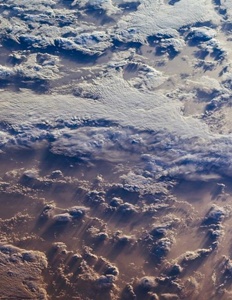Study of aerosols stands to improve climate models
07 Aug 2014
Aerosols, tiny particles in the atmosphere, play a significant role in Earth's climate, scattering and absorbing incoming sunlight and affecting the formation and properties of clouds.
 | |
| Clouds over the southern Indian Ocean. This image was acquired by one of the northward-viewing cameras of the Multi-angle Imaging SpectroRadiometer (MISR) instrument on NASA's polar-orbiting Terra spacecraft. Image credit: NASA/JPL-Caltech |
But now researchers from California Institute of Technology (Caltech) and the Jet Propulsion Laboratory have provided a global observational study of the effect that changes in aerosol levels have on low-level marine clouds - the clouds that have the largest impact on the amount of incoming sunlight that Earth reflects back into space. The findings appear in the advance online version of the journal Nature Geoscience.
Changes in aerosol levels have two main effects - they alter the amount of clouds in the atmosphere and they change the internal properties of those clouds. Using measurements from several of NASA's Earth-monitoring satellites from August 2006 through April 2011, the researchers quantified for the first time these two effects from 7.3 million individual data points.
"If you combine these two effects, you get an aerosol influence almost twice that estimated in the latest report from the Intergovernmental Panel on Climate Change," says John Seinfeld, the Louis E. Nohl Professor and professor of chemical engineering at Caltech. "These results offer unique guidance on how warm cloud processes should be incorporated in climate models with changing aerosol levels."
The lead author of the paper, "Satellite-based estimate of global aerosol-cloud radiative forcing by marine warm clouds," is Yi-Chun Chen (Ph.D. '13), a NASA post-doctoral fellow at JPL. Additional coauthors are Matthew W. Christensen of JPL and Colorado State University and Graeme L. Stephens, director of the Center for Climate Sciences at JPL. The work was supported by funding from NASA and the Office of Naval Research.






























